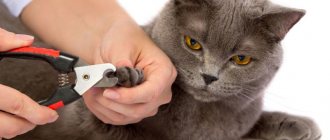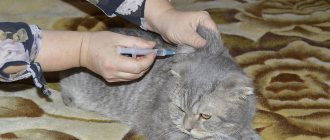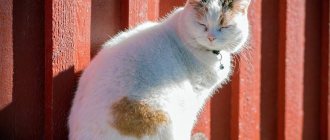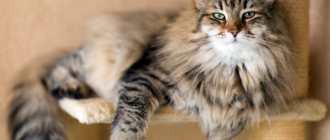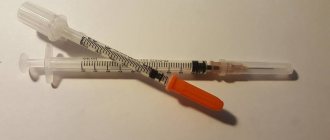02/25/2021 13,692 Diseases and treatment of cats
Author: Olga
If a kitten appears in the house, you will have to learn how to give it an enema. There are quite a few indications for this procedure. Using an enema, we can remove toxins and help your pet with dehydration. This is how certain drugs and nutrients are introduced and the temperature is lowered. But most often cats are given an enema for constipation.
[Hide]
Causes of constipation in furry pets
Diseases of the gastrointestinal tract, kidneys, liver; neurological ailments - each of these disorders can cause regular constipation in furry pets.
Constipation itself is not a disease, but a symptom. As a symptom, it signals the presence of some kind of disease, perhaps in its very initial stage.
As a condition, constipation requires prompt symptomatic treatment. Firstly, the animal experiences heaviness and even pain. Secondly, constipation can lead to intoxication of the entire body.
According to statistics, adults suffer from regular constipation more often than young ones, and cats suffer less often than cats.
But, mostly, owners of furry pets face irregular constipation. The most common causes of irregular constipation are:
- unbalanced diet;
- accidentally swallowed object;
- fur that gets into the gastrointestinal tract when licked.
You can tell if your cat is constipated by the following signs:
- lethargy;
- lack of appetite;
- enlarged, tense abdomen.
Normally, cats should relieve themselves twice a day.
When does a cat need an enema for constipation?
The reason for the procedure may be various obvious symptoms of constipation, as well as a general deterioration in the pet’s condition:
- Long-term absence of stool – in cats up to 3-4 days. Or there is stool, but it is visually determined as unnatural for a healthy animal.
- The general health of the cat is cause for concern - there is no appetite, the cat is lethargic, goes to the toilet, but feces comes out in small quantities.
- A tight belly, discomfort caused by any touch to the abdomen - the cat itself will show you by its behavior that something untoward is happening.
- The animal cannot empty itself on its own - the cat meows, behaves unnaturally, there are attempts to go to the toilet, but they were not successful.
- Vomiting and malaise - the cat is lying down and does not even approach food, there has been no stool for several days - the pet’s well-being is clearly alarming.
Read how else you can cure constipation in a cat.
Enema Supply Guide
So, you have confirmed that your cat is constipated. The delicate mucous membrane of the rectum of an adult cat, and especially a kitten, can be injured during the procedure.
So keep three things in mind:
- An enema is only necessary if other methods (for example, drinking plenty of fluids or taking laxatives) have failed.
- Consult your veterinarian before administering an enema. His opinion is important both about the causes of constipation and about the need for an enema in a particular case.
- Do not perform an enema yourself without thoroughly studying the procedure or if you do not feel confident. A kitten does not like an enema to the same extent as a child. Therefore, the incompetence of the owner, who, instead of relieving the pain, aggravates it, can lead to the loss of the pet’s trust.
Preparation
Have you decided to carry out the procedure at home yourself? - Get ready. An enema is given to a cat using a rubber bulb. You will also need lubricant and salted water.
The following are suitable as a lubricant (a material that levels friction and prevents injury to the mucous membrane):
- fat cream;
- vegetable oil;
- Vaseline oil.
The tip of the rubber bulb should be generously lubricated with lubricant.
Why do they use salted water to give a cat an enema? – So that it is not absorbed by the intestinal walls. The concentration of the saline solution is 1 teaspoon of ordinary table salt (preferably sea salt) per 0.3 liters of boiled water.
If you need to give a kitten (or an adult) not a cleansing enema, but a therapeutic one, use other solutions: manganese, based on decoctions of medicinal herbs.
The enema should be administered using medical gloves. If you don’t have a very good eye, then mark the insertion depth on the nose of the syringe (rubber bulb). It should be equal to two centimeters. If you are going to give an enema to a kitten, then this distance should be less (1 - 1.5 centimeters). The pear needs to be small in size, holding up to 100 ml of liquid.
Is it possible to take a larger bulb without filling it completely? - No. After all, a large syringe will have a thicker tip. To avoid injury to the animal, such a tip should not be inserted into the cat's anus.
If we are talking about an enema as an aid in the treatment of constipation, then the administered solution should have a temperature of 28 ± 2 ° C.
It would also be useful to prepare:
- Napkins and cloths. The bigger, the better.
- A convenient container into which the “waste” solution will flow out along with the kitten’s feces. The container should be larger than the cat you are going to put in it.
As for the location of the procedure, let it not be a new sofa or an expensive carpet. We would say that the optimal place for an enema would be the bathroom, because it is easiest to clean up after a treatment event there. But only if your cat is familiar with this bathroom and has had water treatments in it before.
After all, a cat (and especially a small kitten) can be frightened by a booming voice, which it becomes in an empty bathroom with tiled walls. But the animal is already in a stressful state, both because of physical suffering and because of the owner’s preparations that are still incomprehensible to him.
A certain amount of stress that a sick animal experiences can force it to look for secluded corners to hide from its owner.
Stages
The procedure is carried out on an empty stomach in stages.
Stage one
There are different techniques for holding a cat during an enema. Many experts believe that the animal should not lie down, but stand during the procedure.
Ideally, your assistant, whom the cat knows well, should hold the pet. This could be a wife or an already quite old child. If you do not have an assistant, you need to place the animal on your right hand if you are going to work with your left. And to the left if you are right-handed.
Not a single cat, even the most obedient one, will lie still, no matter how carefully a rubber bulb is inserted into its anus. Therefore, you need to hold the animal firmly, without causing him unnecessary pain.
Stage two
Place the enema solution into the bulb. How much solution is needed? 50-100 ml, depending on the size of the animal. Before inserting the tip, squeeze the bulb lightly so that a few droplets of water come out. This is done to ensure that completely unnecessary air does not enter the cat’s intestines.
After this, the tip, previously lubricated with lubricant, is carefully inserted into the animal’s anus with screw-like movements. The direction of administration should be parallel to the spine of the sick pet.
Then the solution is gradually introduced. An overdose of the solution in the case of an enema is difficult to achieve. Excessive liquid will flow out.
Stage three
After administering the solution, you need to close the pet’s anus with her own tail and hold it in this position for a quarter of an hour. This time is necessary for the leaching of fecal matter. After 15 minutes, place the cat in the basin and allow the softened feces to come out.
To achieve a better effect, the enema can be repeated after one and a half or two hours.
Types of enemas
There are two types of manipulation: medicinal and cleansing. The first involves the oral administration of medicinal formulations for local relief of symptoms. This form is prescribed only by a veterinarian to remove accumulated masses in areas of inflammation. A cleansing enema is used to remove accumulated fecal matter from the colon. The composition used begins to liquefy the seals, enhances peristalsis and removes excrement from the body.
Both types are carried out by specialists and amateurs using a gas outlet tube, which can be purchased at a veterinary hospital or at a regular pharmacy. The advantage of this device is the small diameter of the nozzle, which is well suited for pets. The cleaning composition is administered using a large-volume medical syringe.
You can use a Microlax enema with the addition of Vaseline. This mixture not only cleanses, but also promotes the healing of microcracks on the intestinal walls. Chamomile decoction also helps well, as it relieves pain, relieves inflammation and kills dangerous microorganisms.
The type of enema, as well as the substance administered, can only be recommended by a veterinarian - he will make a prescription after determining the cause of constipation, its severity and diagnosing the characteristics of the animal’s body.
In what cases should you not give an enema to an animal?
An enema can help or harm a cat. Use an enema only as directed by your veterinarian.
After all, only a doctor can diagnose diseases for which constipation cannot be treated with an enema:
- inflammatory processes, bleeding, tumors in the rectum;
- volvulus;
- haemorrhoids;
- severe forms of chronic diseases of internal organs.
Brief conclusions
The process is unusual and painful for a cat, so it is not recommended to start an enema without preparation.
Here are the basic tips:
- We carry out the procedure on an empty stomach, preferably in the morning.
- We use only the recommended solution in the dosage that can be administered according to the weight and age of the pet.
- Making an enema with Microlax is the easiest and safest way. But before that, be sure to read the instructions.
- We remember that constipation can be caused not only by stool clots, but also by congenital anomalies or inflammatory diseases.
- If an enema does not help, be sure to listen to the veterinarian’s recommendations, or better yet, visit the clinic (for an ultrasound and tests).
- You can’t exclude natural products from your pet’s menu, including fermented milk and vegetables.
- Special premium canned foods perfectly regulate the gastrointestinal tract to stimulate peristalsis. Probiotics and feed additives do the job just as well.
Remember: an enema is a simple, but very serious procedure that can both help and harm. This express method can remove the consequences of gastrointestinal disturbances, but it does not cope with the cause of the disease.
Therefore, when starting to cleanse the intestines, treat everything that happens responsibly. If the injected solution does not help the cat to empty its intestines, it is better not to hesitate and immediately seek professional advice. Be sure to monitor the animal’s further well-being after the procedure.
And if your cat, on the contrary, has diarrhea, read how to treat it at home.
Veterinarian recommendations
As recommendations, here are the veterinarian's notes:
- The best time to perform an enema is early in the morning.
- Talk to your pet, stroke him. Your calmness and calming tone will prepare the cat, and he will be more willing to trust you.
- Massaging the cat's abdomen under the pelvis will help loosen the fecal impaction. It is in this area that you can feel hard stool.
- Pay attention to the color of the feces excreted with the solution. If they are stained with blood, this may indicate injury to the rectum. This situation requires the intervention of a specialist.
Author of the video channel “And the veterinarian is against!” Veterinarian by profession. In this video, he talks about when to give an enema to a cat.
Sorry, there are no surveys available at this time.
What not to do
It is recommended to carry out the procedure on your own only after consultation with a specialist:
- Also, you should not choose enema compositions on your own. One solution may be suitable for a cat, but the same mixture may not be administered as an enema to children.
- If it is visually determined that the fluid does not enter the intestine, we immediately stop the procedure. This may indicate that the stool is very thick, possibly hairballs. This can also be a sign of an internal tumor.
- When an animal begins to violently resist, you should not use force. It is enough to give or inject a sedative to the cat - the procedure will become much easier.
An important point: if after 1-2 procedures the animal’s defecation is still difficult and only water comes out, immediately contact a specialist.
Video “Enema for a cat at home”
In this story from the “Children of Fauna” channel, its author, a veterinarian by profession, tells and shows how to give an enema to a cat.
Was this article helpful?
Thank you for your opinion!
The article was useful. Please share the information with your friends.
Yes
No
X
Please write what is wrong and leave recommendations on the article
Cancel reply
Rate the benefit of the article: Rate the author ( 7 votes, average: 4.14 out of 5)
Discuss the article:
What you need to prepare for the procedure
To give an enema to a kitten or an adult pet, you need to prepare. For the procedure you will need:
- Stack of old newspapers
. They can be used to cover the floor in a bathroom or other room, so as not to stain the floor with feces liquefied by the enema; - Rubber enema-syringe
with a volume of 30-50 ml for a kitten and 100-200 ml for an adult animal; - A little Vaseline or baby cream
to lubricate the tip of the syringe; - Water temperature is about 30 degrees
. Water with a temperature of 20 degrees or less can cause severe intestinal spasms, and very warm water (more than 40 degrees) can provoke intoxication of the body if there is a lot of feces accumulated in the intestines; - 3-5 ml of Vaseline oil
(half as much for a kitten) or 1-0.5 tsp. glycerin. A glycerin or vaseline enema for a cat helps to quickly soften and excrete feces, but before carrying out a procedure with such drugs, it is better to consult a doctor. If you have neither petroleum jelly nor glycerin on hand, an enema for a cat with constipation can simply be a water one; - A basin or tray
so that the animal can poop after the procedure; - Gloves
. They are optional, but desirable so that the owner does not inadvertently get his hands dirty; - Assistant
. It is much more convenient to do an enema for a cat together. One person will hold the animal, the other will insert the syringe into the anus.
What should alert the owner?
But the first signs in which constipation can be suspected, and which tell the owners that cleansing treatment is necessary, are very eloquent. This:
- strange behavior of the cat when visiting the litter box: uncharacteristic sounds. Plaintive meowing, frequent but “idle” trips to the litter box;
- hard excrement, sometimes there is mucus and blood in the tray;
- absence of excrement for one or two days, whereas usually the cat poops a couple of times a day;
- poor appetite for a long time;
- anxiety during caresses, especially dissatisfaction is caused by touching the abdominal area;
- upon palpation, the animal’s abdomen may tense and be hard;
- the cat behaves sluggishly or restlessly: does not play, does not lick itself, tries to hide, moans or makes plaintive sounds.
Leaving feces inside for a long time poisons the animal’s body.
How often can you give an enema and when should you not do it?
In general, giving an enema should be rare so as not to disrupt peristalsis. No more than 2 times every 7 days. There are such types of enema: cleansing and therapeutic.
At the clinic, a specialist will be able to not only give an enema, but also see how it turned out. If there is no result, repeated manipulation is prescribed. If it is impossible to achieve the desired result after a double procedure, the animal needs help of a different order, depending on the causes of constipation.
There are cases in which it is prohibited to give an enema:
- the cat is pregnant;
- presence of injury or inflammation of internal organs;
- tumor-like neoplasms or polyps in the intestines;
- there is suspicion of intestinal bleeding;
- heart problems, congenital heart defects, irregular breathing.
However, often such contraindications are perfectly disguised and are not noticeable to the average person. Therefore, be sure to consult a specialist to determine the real cause of constipation.





